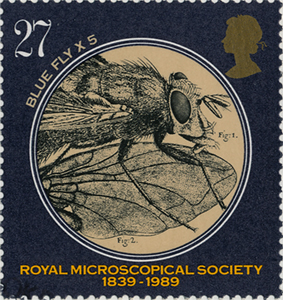
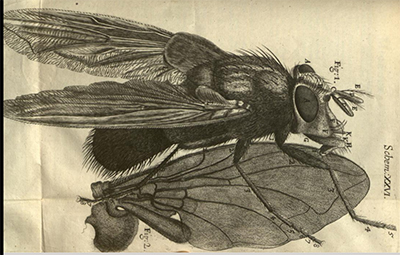
|
A gallery of postage stamps and postal stationery showing aspects |
I wouldn't describe myself as a philatelist but as a microscopy enthusiast I do enjoy collecting philately items on selected themes related to microscopy. I particularly like the challenge of seeking those out on narrower themes from the many hundreds of microscopy related stamps that have been issued. Galleries shared to date include selected microscopy, photomicrography, diatoms and radiolaria. Fritz Schulze has also shared his own attractive selection in his 'Microscopes and Stamps' article.
The contributions of both Hooke and Van Leeuwenhoek to science related to microscopy requires no introduction. Notable online resources describing their life and work include the Robert Hooke Society website and Douglas Anderson's definitive Lens on Leeuwenhoek website.
To date I have only found a handful of philately related items depicting some aspect of either Hooke or Van Leeuwenhoek and are shared below. I would be very interested to hear of others.
Robert Hooke and Great Britain philately: The only GB stamp I've come across that depicts some aspect of Hooke's life and work is one of the four stamps issued to celebrate the Royal Microscopical Society's 150th Anniversary in 1989. The attractive and informative illustrated fold-out card that came with the 'Presentation Pack' also has a section describing aspects of Hooke's work.
This stamp set when issued was the first that alerted me to the world of collecting thematic stamps associated with my interests, both microscopy and otherwise. Dr. Peter Evennett played a large part in the Royal Mail issuing a set to celebrate the RMS Anniversary. He describes the long process from initial proposal through to design and final production in his fascinating article 'The Royal Microscopical Society Stamps', Proc. RMS, 1989, July, vol. 24/4, 231-7.


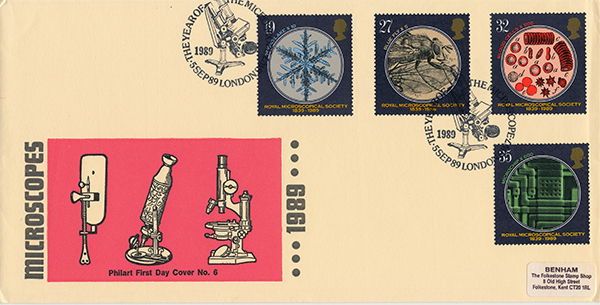
Above. Great Britain, Hooke 1989. 150th Anniversary of the Royal Microscopical Society.
Left upper. The stamp in the set of four that depicts the 'Blue Fly' from Micrographia. For legibility the stamp designers have rotated and relocated the original figure numbers.
© Stamp Design Royal Mail Group Ltd (1989).
Right upper. The original engraving 'Schem: XXVI.' accompanying 'Observ. XLII. Of a blue fly' page 182 from Hooke's Micrographia 1665. Sourced from a copy in the public domain on www.archive.org.
Lower. A first day cover showing the full set and which includes an envelope design depicting both Van Leeuwenhoek's single lens and Hooke's compound microscope.
Envelope design © Philart 'First Day Cover No. 6'. Stamps © Stamp Design Royal Mail Group Ltd (1989).
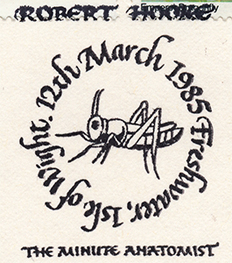

Above. Great Britain postmarks, Hooke. Some postmarks have been identified to date that have a Hooke theme.
Left. A postmark used on a first day cover for the set of insects issued in 1985. © Stamp Design Royal Mail Group Ltd (1989).
Right. A postmark used on a first day cover for the RMS 150th Anniversary in 1989. Not a rigorously accurate postmark: He was born on the Isle of Wight but shows a modern compound microscope. © Stamp Design Royal Mail Group Ltd (1989).
Added April 14th 2016: The righthand postmark above uses the title 'Dr. Robert Hooke'. The entry for Robert Hooke in the Royal Society's list of past fellows notes that he was awarded a Lambeth MD in 1691 i.e. ca. 12 years before his death in 1703 (see Wikipedia entry Lambeth degree and Oxford Dictionary of National Biography entry).
Antoni van Leeuwenhoek and the Netherlands philately: I have only come across one Dutch stamp related to Van Leeuwenhoek, this is his portrait shown below issued in 1937. Perhaps any reader familiar with this country's stamps could enlighten me as to any I've missed. I find it surprising that such a well known and influential man isn't more widely celebrated on their stamps. The tercentenary of Leeuwenhoek's death isn't far away in 2023— an excellent opportunity to celebrate his life and work on stamps.
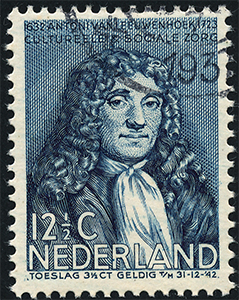

Above. Netherlands, 1937.
Left. Van Leeuwenhoek shown in one of a set of four of famous personalities. The portrait seems to most closely resemble the 'mezzotint engraving' by Verkolje dated 1686 as described by Dobell. The differences may suggest it was based on one of the derivatives known.
Right. The stamp of Franciscus Sylvius in the set is also shown—he was a Dutch physician and chemist who taught both Swammerdam and Reinier de Graaf. The latter, by correspondence, introduced Leeuwenhoek and his work to the Royal Society to which many of his famous letters were addressed.
Hooke and Van Leeuwenhoek depicted on stamps world wide: For reasons I'm uncertain of, African countries celebrate these figures most frequently and typically in their respective great scientists series.
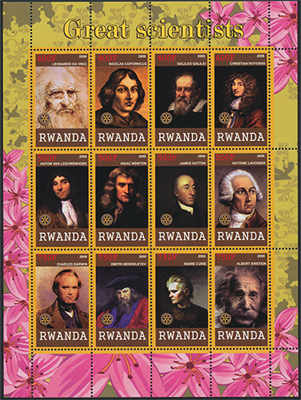
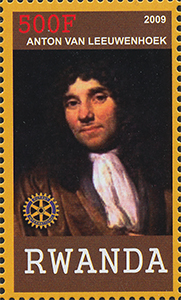
Above. Van Leeuwenhoek, Rwanda 2009, 'Great Scientists' series showing the sheet and stamp. The portrait seems to be a faithful part reproduction of the painting by Johannes Verkolje dated 1686 (see the section 'The portraits of Leeuwenhoek' in Clifford Dobell's definitive biography 'Antony van Leeuwenhoek and his "Little Animals"' pub. 1932 and also the Lens on Leeuwenhoek website).
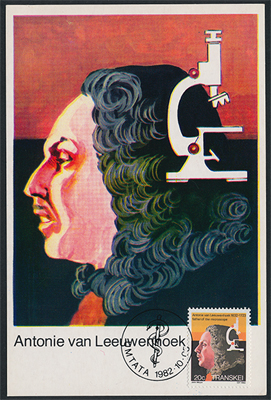
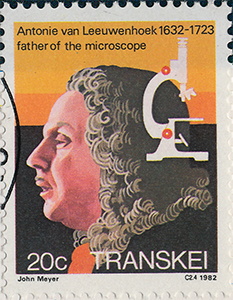
Above. Van Leeuwenhoek, Transkei 1982. Maximum card. Credits, design John Meyer, 'Maxicard Publishers J.G. - T.M.P.'. Maximum cards are commercial postcards with the franked stamp placed on the front with the stamp, card subject and the postmark being associated in some way. Collecting such cards is a formal branch of philately called maximaphily. See earlier article on 'Microscopy themed maximaphily'.
Right, stamp detail. Dobell notes two known profiles of Leeuwenhoek. The profile on the medal awarded to him by the University of Louvain shows him when older and does not resemble the stamp profile. The microscope shown is a modern compound microscope rather than the single lens microscope to his own design which he used to great effect. '
'Father of the microscope' as used on the above stamp is a widely used term associated with Leeuwenhoek but it's a rather ambiguous phrase and potentially causing misinterpretation of his achievements. The full Oxford English Dictionary online defines 'father' in this context as "An originator, inventor, or founder of something; an important male figure in
the origin and early history of something." The second definition is most certainly appropriate but the first is arguable as he did not invent the single lens microscope and there were important contemporary users of compound microscopes e.g. Hooke who also described how to make a single lens microscope in his Preface to Micrographia, 1665. Brian J Ford, an authority on the single lens microscope, believes that Hooke may have used them to study and present the fine subject detail depicted in some of the Micrographia engravings. He argues that the compound microscope of the time may not have been capable of doing so. See for example 'Celebrating Leeuwenhoek's 375th birthday. What could his microscopes reveal?' by Brian J Ford, infocus Magazine (RMS), 2007, December, issue 8, p.78.
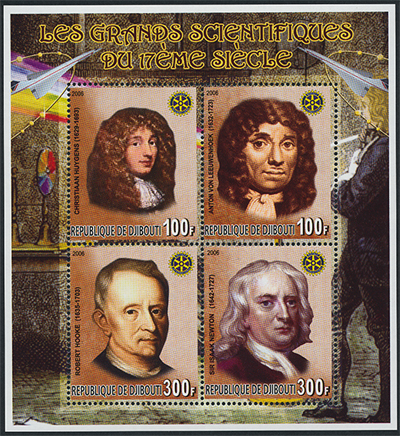
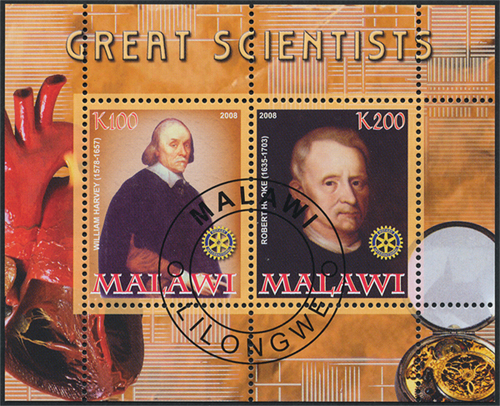
Above. Left - Van Leeuwenhook and Hooke, Republique de Djibouti 2006 in their great scientists of the 17thC series. Leeuwenhoek's portrait seems to most closely resemble the 'mezzotint engraving' by Johannes Verkolje dated 1686 as described by Dobell.
Right - Robert Hooke, Malawi 2008 in their 'Great Scientists' series.
At the time of writing there is no known authenticated portrait of Robert Hooke—possible reasons have been widely discussed. Both Djibouti and Malawi show a portrait that was believed to be of Hooke as reported by the late Lisa Jardine in her splendid biography 'The Curious Life of Robert Hooke: The Man Who Measured London' pub. 2003. Later studies showed that this was incorrect and that it depicts the Flemish chemist and physician Van Helmont (link to Wikipedia entry). See William B Jensen's paper in Ambix 2004 'A Previously Unrecognised Portrait of Joan Baptista Van Helmont (1579-1644).'

Above. Van Leeuwenhoek, USSR 1965 printed envelope. The inset drawing of bacteria does resemble aspects of drawings shared by Leeuwenhoek in his letter on bacteria from his mouth dated 17th Sept. 1683.
Grenada: This tiny Caribbean island has issued my favourite stamp designs found to date for both Van Leeuwenhoek and Hooke. They particularly appeal because of their commendable accuracy in all their design features. It's a pity that the designer doesn't receive a credit on the stamp.
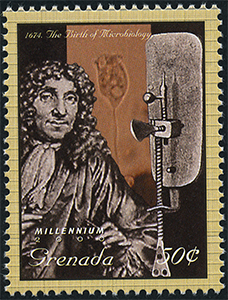
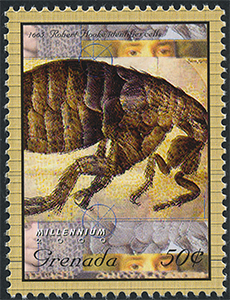
Above. Grenada Millennium 2000 series.
Left - Van Leeuwenhoek, '1674 The Birth of Microbiology'. The portrait is a faithful part reproduction of the 'mezzotint engraving' by Verkolje dated 1686 as described by Dobell. The vertical microscope closely resembles one of the extant models held at the Museum Boerhaave, Leiden—the only one with the distinctive three holes in the handle. The photomicrograph shows a peritrich, a stalked protozoan. Vorticella, an example of this type was
first reported by Van Leeuwenhoek.
Right - '1665 Robert Hooke Identifies Cells'. The dominant design feature is a faithful reproduction of one of the most famous engravings ('Schem XXXIV') illustrating 'Observ. LIII. Of a Flea.' in Hooke's Micrographia. Smaller design features include close-ups of the exoskeleton and a section of cork in which the porous 'cell' structure was described and illustrated. The unidentified image of the part face may be a neat way of illustrating Hooke as the curious observer but sidestepping the lack, as remarked, of an extant portrait. Hooke likened the cells in the section of dry porous cork to those in a honeycomb. Many online resources note that he likened the cells to those in a monastery but can find no reference to this in Micrographia and uncertain where it arose. The cell as a fundamental biological unit wasn't identified until much later, notably by the 19th century workers Schleiden and Schwann (see Wikipedia 'cell (biology) entry).

Above. Van Leeuwenhoek, Antigua and Barbuda 1992. Another small Caribbean nation also issued an attractive stamp. The redrawn portrait is close to the depictions of the time and the microscope is a near faithful drawing of the most famous remaining microscope, that held by Utrechts University Museum (the notch at the top of the plate is distinctive). This has the finest performing lens of the extant microscopes and has been determined by van Zuylen to be aspheric (mag 266X, NA0.37) . See J. van Zuylen, 'The Microscopes of Antoni van Leeuwenhoek', J. of Microscopy, 1981, 121/3, pp. 309-328.
Comments to the author are welcomed.
Image acknowledgements. The copyright of the stamps and envelope designs remains with the originators and have been credited where known. They are presented here at a limited size as an educational resource on this not-for-profit website. If a copyright holder wishes to contact the author please use the email above. Thank you.
Revised April 14th 2016 noting the source of Robert Hooke's MD.
Published in the April 2016 edition of Micscape.
Please report any Web problems or offer general comments to the Micscape Editor .
Micscape is the on-line monthly magazine of the Microscopy UK web site at Microscopy-UK
©
Onview.net Ltd, Microscopy-UK, and all contributors 1995
onwards. All rights reserved.
Main site is at
www.microscopy-uk.org.uk.